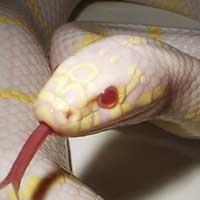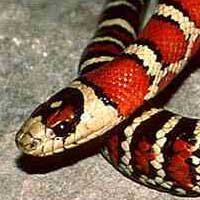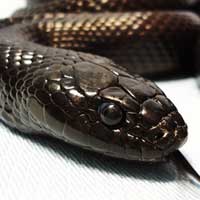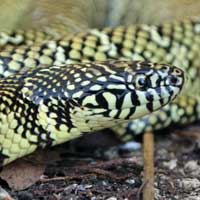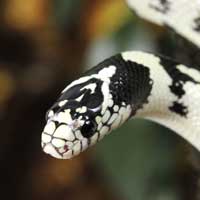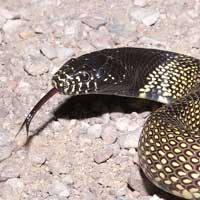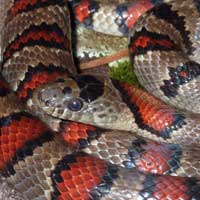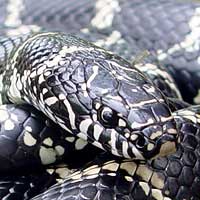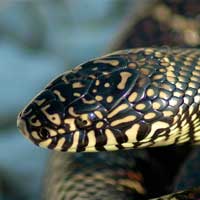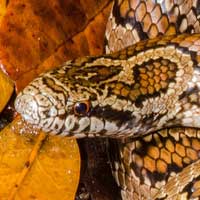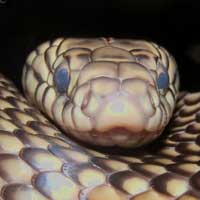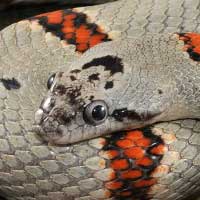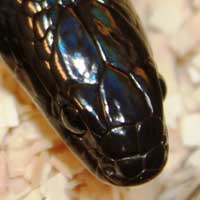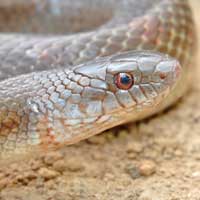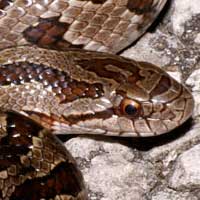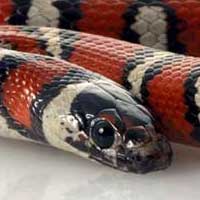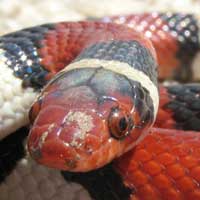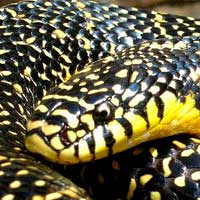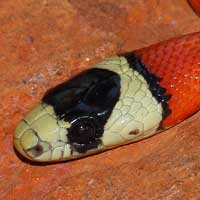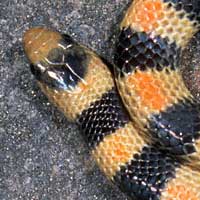Kingsnakes
Kingsnakes rule.
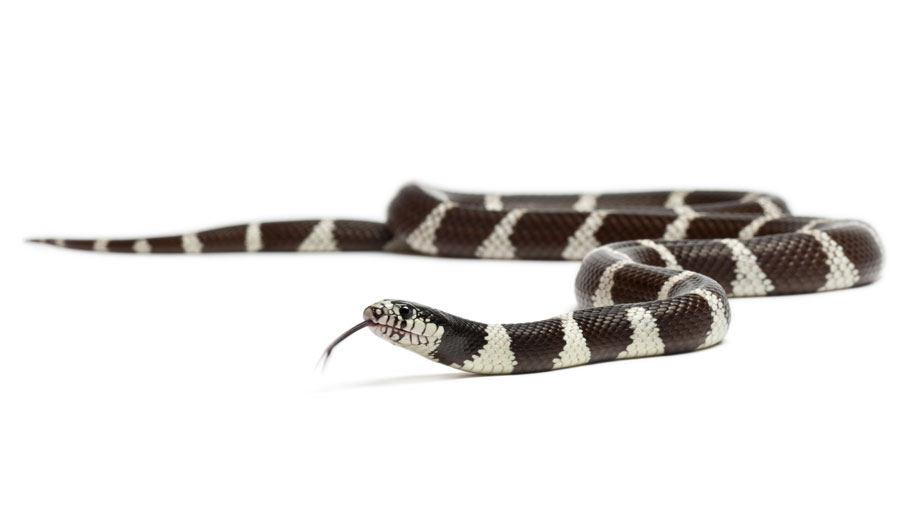
Kingsnakes are medium-size nonvenomous snakes that kill by constriction. They are one of the most common snakes in North America. They are called kingsnakes because they sometimes eat other snakes, as does the king cobra. Kingsnakes are popular among pet owners. Milk snakes are a type of kingsnake.
Kingsnakes are members of the family Colubridae and the subfamily Colubrinae. Colubrid snakes are a large family of nonvenomous snakes found around the world, including North America. Kingsnakes are members of the genus Lampropeltis. In Greek, this means “shiny shields,” according to Anapsid.org. The name is appropriate for the genus, which is known for its well-defined, glossy scales.
Physical characteristics and distribution
Most species of kingsnake have vibrant patterns on their skins with vivid contrasting colors. The patterns, especially bands and speckles, break up the snake’s body outline so it is less visible to predators like birds of prey, mammals like foxes and coyotes and other snakes, according to the San Diego Zoo.
Their coloring can be understood by their geographic location, according to Savitzky. For example, the farther west one goes in the eastern kingsnake’s range, the more the snakes’ coloring resembles the black kingsnake, which lives in Tennessee.
According to the Smithsonian National Zoological Park, they have smooth scales, a single anal plate, round pupils like most nonvenomous snakes, and a spoon-shaped head with a rounded jaw. They typically range from 2 to 6 feet (0.6 to 1.8 meters), depending on the species.
The following is a description of some common kingsnake species’ appearances and ranges.
Kingsnakes Are Amazing Creatures
Diet
Kingsnakes are constrictors. This means that they squeeze their prey to death and swallow it whole.
There are some common misconceptions about how constricting works, Heyborne told Live Science. One is that constrictors crush or break the bones of their prey. Another is that they suffocate it, squeezing the prey’s lungs too tightly to work.
“It turns out that the squeezing overwhelms the circulatory system,” explained Heyborne. “Blood cannot get to the brain, and the animal dies within seconds due to ischemia.”
RODENTS
AMPHIBIANS
BATS & BIRDS
REPTILES
EGGS
Indigenous Habitat
Across their various ranges, kingsnakes find similar habitats to live in. They live in forests, grasslands, suburbia, and rocky areas in fields and deserts. Snakes in wetter areas, such as the eastern and southern United States spend more time around swamps and riverbanks. They are terrestrial, meaning they stay mostly on land rather than venturing into water or trees.
Kingsnakes are less conspicuous than many other snakes, such as rat snakes. “This is because they are adapted to living undercover, such as under rocks, under logs, and in burrows in the ground.”
Reproduction
Kingsnakes are oviparous, meaning they lay eggs that spend little to no time incubating inside the mother. Their mating time depends on the climate, with snakes in warmer climates mating earlier in the spring and snakes in colder climates waiting until late spring or summer. In general, mating season lasts from March until August, and females often have more than one clutch of eggs per season.
Males seek out females through chemical scent. They will fight each other for a female, wrestling other males until their heads are flat on the ground. Males often bite the female’s neck during mating, according to the Savannah River Ecology Laboratory.
Female kingsnakes lay clutches of three to 24 eggs in debris, rotting logs or other secluded places. Mothers then leave the eggs, which hatch on their own two to three months later, according to the San Diego Zoo. Hatchlings can be up to a foot long and are completely independent from the moment they enter the world.
Kingsnakes reach sexual maturity between 2 and 4 years of age. Their lifespan in the wild is unknown, though they can live up to 20 to 30 years in captivity, according to the San Diego Zoo.
Sub-Species & Morphs
If you’re curious, let one of these kingsnakes bite you.
How to Take Care of a Kingsnake
A king snake is a very good choice as a pet for the experienced and the inexperienced, and the reason why is not only are they beautiful, but they’re a much more docile snake. They can grow to be six to seven feet long. They can live sometimes 15 to 20 years. It’s important to know this, because when you get this good-looking guy you’ve got to be ready to take care of him for a good 15 years.
Now pink snakes are carnivorous and they’ll eat mice readily. When they’re smaller you’ll go with pinkies, and a good easy way of figuring out how to feed and how much to feed is to find the thickest part of the snake’s body, and this width should be the width of the bait that you feed. It should not be more than this. It’s a good gauge to try to figure out what size you should feed your snake.
A king snake and milk snakes, some of them have these beautiful bands, can sometimes resemble coral snakes which are poisonous. A coral snake which has yellow, red, and black bands, the yellow always touches the red. For your milk and your kings, the black will touch the red.
So that’s a good way of figuring out whether you’ve got to run or not. If you see a snake that looks like this, but has yellow touching red, you better dread and get on your way. If it’s black and red it’s this friendly old king snake, and you don’t have anything to worry about.
Now these guys you can find anywhere in the United States and in Mexico, so they’re very easy to take care of. For the terrarium they require a heat gradient of about the mid to high 80’s down to even 75 degrees. They can be shy and they like hiding spots. So it’s very important to make sure that we have a hiding spot in the terrarium. Very important, otherwise they’ll really be stressed. And it should be just big enough that they can fit in where the sides of the snake will touch the sides of the hiding spot. A pot for plants, cardboard box, anything will do, but it’s very important.
For humidity, they do very well in about 50 to 60%, and the easy way of controlling that is having a water area, a little basin that has a little bit of water, just enough to where it covers the snake. That will control humidity. It also helps this little guy with his digestion and going to the bathroom, and it also sometimes can be very helpful in times of shedding, because it’ll keep things moist and make the skin easier to shed. I hope those are some good helpful hints for you for taking care of your king snake.
